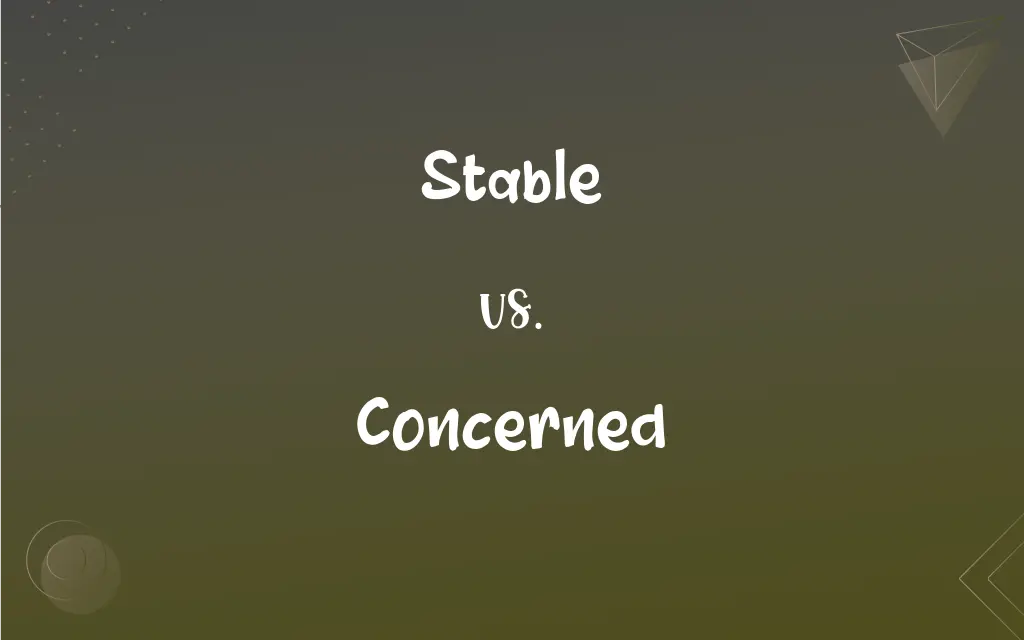Stable vs. Concerned: What's the Difference?
Edited by Aimie Carlson || By Janet White || Updated on March 3, 2024
"Stable" refers to a state of consistency, reliability, or lack of change, often used in medical or structural contexts. "Concerned," denotes a state of worry, care, or interest about someone or something, highlighting an emotional engagement.

Key Differences
Stable is a term that implies steadiness, reliability, and lack of significant change. In a medical context, it often describes a patient's condition that is not changing significantly in either direction, indicating no immediate danger to health. In other contexts, such as engineering or finance, stable suggests something is firmly established, not likely to falter or collapse. Concerned, conversely, is an adjective that describes a state of worry, care, or interest regarding a particular situation or the well-being of someone. Being concerned involves emotional or cognitive engagement with an issue, reflecting an individual's care or apprehension about potential outcomes.
The essence of being stable is in its lack of change, suggesting a sense of security or permanence. It is often a desired state, indicating that no immediate action is needed to rectify or improve the situation. Stability can be a goal in various aspects of life, from personal health to financial situations, as it suggests predictability and control. Being concerned, however, implies an active engagement with potential issues or problems. It can motivate individuals to take action, seek more information, or offer support where needed. Concern can be both personal and collective; individuals or groups may be concerned about issues that affect their community or society at large, such as public health concerns or social justice issues.
While "stable" and "concerned" are distinct in their meanings, they can be related in certain contexts. For example, a doctor might describe a patient's condition as stable but remain concerned about potential complications that could arise, indicating a cautious optimism. In this way, the terms can complement each other, describing different aspects of a situation or perspective.
Comparison Chart
Definition
Indicating reliability, consistency, and lack of significant change.
Denoting worry, care, or interest about someone or something.
Context
Often used in medical, structural, financial, and various other contexts.
Primarily emotional or cognitive, relating to worry or care about issues or individuals.
ADVERTISEMENT
Implication
Suggests security, predictability, and control.
Implies emotional engagement and potential motivation to address an issue.
Desired State
Generally seen as positive, indicating no immediate action is required.
Can be positive in showing empathy or care, but also indicates worry or apprehension.
Relation to Change
Implies a lack of change or fluctuation.
Suggests concern about potential or actual changes and their implications.
Stable and Concerned Definitions
Stable
A stable condition implies no significant change or fluctuation.
The patient's vital signs are stable, showing no signs of deterioration.
Concerned
Concern can also denote interest or engagement with social or environmental issues.
They are particularly concerned about the issue of plastic pollution in oceans.
ADVERTISEMENT
Stable
In structures, stable suggests a strong, reliable foundation.
The bridge is designed to be stable even under extreme weather conditions.
Concerned
It can imply anxiety or apprehension about potential outcomes.
The community is concerned about the impact of the new development on local traffic.
Stable
A stable economy is characterized by steady growth and manageable inflation rates.
Investors prefer stable economies as they offer lower risks.
Concerned
Being concerned can motivate individuals to respond or take action.
The government is concerned about the rising unemployment rates and is implementing new policies.
Stable
Stability can also refer to emotional or mental steadiness.
After a period of turmoil, she has finally reached a stable state of mind.
Concerned
Being concerned often involves worry about someone's health or wellbeing.
He was deeply concerned for his sister's health after the diagnosis.
Stable
Stable relationships are marked by consistency and reliability over time.
Their friendship has remained stable through various life changes.
Concerned
Concerned indicates a level of emotional involvement or care.
As a teacher, she's concerned about her students' success and wellbeing.
Stable
Resistant to change of position or condition; not easily moved or disturbed
A house built on stable ground.
A stable platform.
Concerned
Interested and involved
Sent a memorandum to those concerned.
Stable
Not subject to sudden or extreme change or fluctuation
A stable economy.
A stable currency.
Concerned
Having or showing concern; worried or anxious
The concerned parents of youthful offenders.
Stable
Maintaining equilibrium; self-restoring
A stable aircraft.
Concerned
Showing concern.
There was a concerned expression on her face as I told her the news.
Concerned
Involved or responsible.
The people concerned have been punished.
Concerned
Simple past tense and past participle of concern
Concerned
Disturbed; troubled; solicitous; as, to be much concerned for the safety of a friend.
Concerned
Feeling or showing worry or solicitude;
Concerned parents of youthful offenders
Was concerned about the future
We feel concerned about accomplishing the task at hand
Greatly concerned not to disappoint a small child
Concerned
Involved in or affected by or having a claim to or share in;
A memorandum to those concerned
An enterprise in which three men are concerned
Factors concerned in the rise and fall of epidemics
The interested parties met to discuss the business
Concerned
In relation (or in regard) to; especially as in the phrases;
As far as x is concerned
Where x is concerned
Concerned
Culpably involved;
All those concerned in the bribery case have been identified
Named three officials implicated in the plot
An innocent person implicated by circumstances in a crime
FAQs
How can one manage concerns effectively?
Managing concerns effectively can involve gathering information, seeking support, engaging in problem-solving strategies, and taking proactive steps to address the cause of the concern.
How can stability be maintained in a fast-changing environment?
Maintaining stability in a fast-changing environment often requires adaptability, robust planning, and the ability to anticipate and mitigate potential disruptions.
Is it normal to feel concerned about positive changes?
Yes, it's normal to feel concerned about positive changes as they can still involve uncertainty and require adjustments, which can be challenging.
Can a situation be stable but still cause concern?
Yes, a situation can be stable but still cause concern if there are potential risks or uncertainties involved that might change the current stability.
What are some signs of a stable relationship?
Signs of a stable relationship include consistent communication, mutual respect, reliability, and the ability to navigate challenges together.
What strategies can organizations use to remain stable in uncertain economic times?
Organizations can use strategies such as diversifying income streams, controlling costs, maintaining liquidity, and investing in employee well-being to remain stable during uncertain economic times.
Can being overly concerned be harmful?
Being overly concerned can be harmful if it leads to excessive worry or anxiety, potentially impacting one's mental health and ability to make rational decisions.
What role does stability play in child development?
Stability plays a crucial role in child development by providing a secure and predictable environment, which is essential for healthy emotional, psychological, and physical development.
How does stability affect mental health?
Stability can positively affect mental health by providing a sense of security and predictability, which can reduce stress and anxiety.
How do environmental conservation efforts contribute to global stability?
Conservation efforts help maintain biodiversity, protect ecosystems, mitigate climate change impacts, and ensure sustainable use of natural resources, all of which are vital for global stability.
What strategies can help individuals manage their concerns about future uncertainties?
Strategies include staying informed, focusing on what can be controlled, practicing mindfulness and stress-reduction techniques, setting realistic goals, and seeking support from trusted individuals or professionals.
How can communities work towards environmental stability?
Communities can work towards environmental stability by promoting sustainable practices, protecting natural resources, and advocating for policies that support long-term ecological balance.
Can environmental stability be achieved in the face of rapid industrialization?
Yes, through sustainable development practices, renewable energy adoption, stringent environmental regulations, and technological innovations that reduce industrial impact on the environment.
What role does community support play in personal stability?
Community support provides a safety net during challenging times, offers resources and assistance, and fosters a sense of belonging and security, contributing to personal stability.
How can technology contribute to stability in various sectors?
Technology can enhance stability through improved data analytics for decision-making, automation of repetitive tasks, enhanced communication, and innovative solutions to traditional problems.
What are common indicators of economic stability?
Common indicators include low and stable inflation rates, steady GDP growth, low unemployment rates, and balanced government budgets.
How can individuals contribute to maintaining a stable community?
Individuals can contribute by participating in local governance, supporting local businesses, engaging in community-building activities, and promoting inclusivity and cooperation.
What measures can be taken to stabilize a volatile market?
Measures include regulatory oversight, monetary policy adjustments by central banks, market transparency initiatives, and investor education to mitigate panic-driven decisions.
How does political stability influence foreign investment?
Political stability creates a predictable and secure environment for investments, reducing risks associated with policy changes, civil unrest, or government instability, thereby attracting foreign investors.
What psychological effects can prolonged instability have on individuals?
Prolonged instability can lead to chronic stress, anxiety, depression, and feelings of insecurity, impacting overall mental health and well-being.
About Author
Written by
Janet WhiteJanet White has been an esteemed writer and blogger for Difference Wiki. Holding a Master's degree in Science and Medical Journalism from the prestigious Boston University, she has consistently demonstrated her expertise and passion for her field. When she's not immersed in her work, Janet relishes her time exercising, delving into a good book, and cherishing moments with friends and family.
Edited by
Aimie CarlsonAimie Carlson, holding a master's degree in English literature, is a fervent English language enthusiast. She lends her writing talents to Difference Wiki, a prominent website that specializes in comparisons, offering readers insightful analyses that both captivate and inform.































































